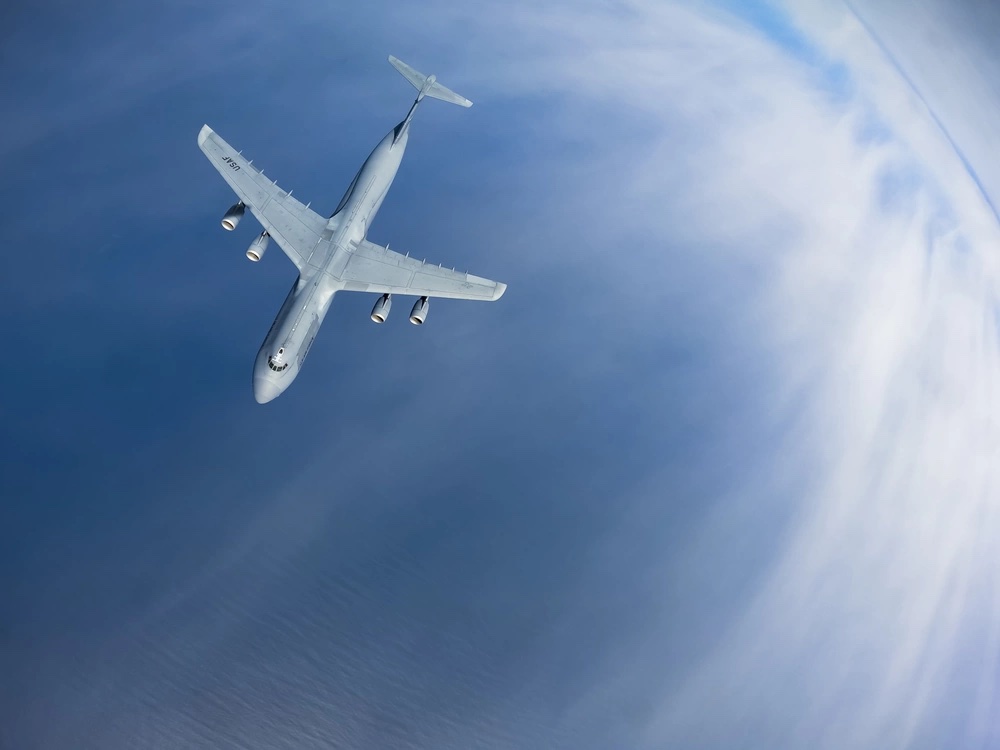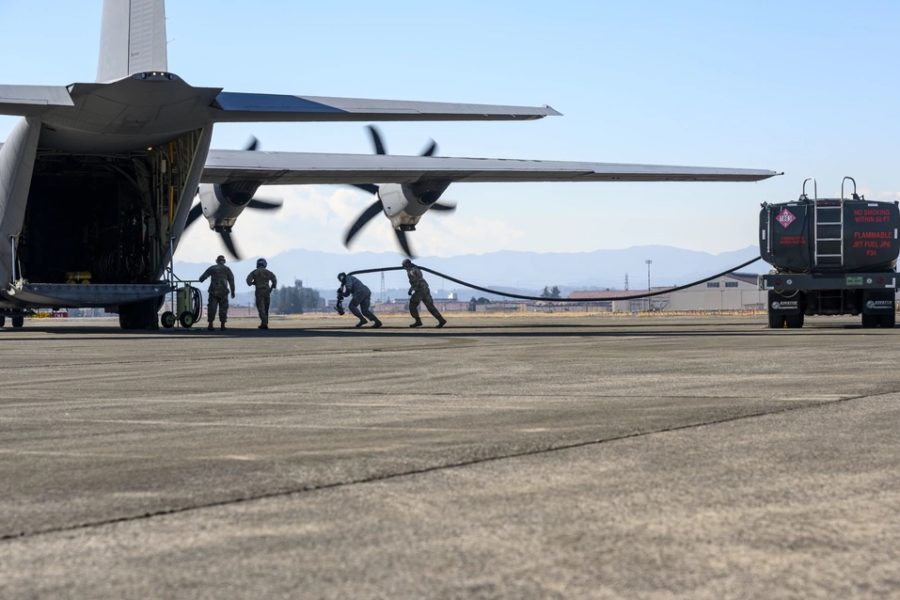The Air Force’s largest aircraft transformed into an oversized fuel transport this past February, when a C-5M Super Galaxy from the 9th Airlift Squadron landed at Dover Air Force Base, Del. and kept half its engines running while Airmen pulled fuel out of the wings and into an R-11 refueler truck.
“The idea is to turn the C-5 into a mobile fuel station that can offload fuel into a refueling vehicle standing by at a forward-deployed location,” Master Sgt. Brent Gregory, operations superintendent for the 9th Airlift Squadron, said in a press release about the experiment. “In theory, a cargo aircraft can land in an austere environment, offload fuel using the aircraft pumps and take off with minimal time on the ground.”
It’s not the first time the Air Force has used transport aircraft to haul and pump gas. In 2020 a C-130 refueled a pair of F-22 fighters on the ground in Hawaii, and this past December, a C-17 refueled a B-2 bomber on the ground in California. Transport aircraft can also defuel into a bladder or other facilities at an airfield.
Delivering gas with cargo aircraft may seem out of character for a branch that takes great pride in its fleet of aerial tankers, but it could give commanders more options in a future conflict.
Many national security experts are warning of a potential conflict with China in the western Pacific, and the Air Force is preparing to disperse its operations so that it is more difficult for the Chinese to select an airfield to target. But part of the challenge of dispersed operations is that small airfields do not have the pipelines or deep supplies of fuel often found at larger bases.
“Sending fuel forward to those bases would be necessary, and most of them are not the kind of places where you could pull up a ship alongside and unload a whole lot of fuel,” Jeremiah Gertler, a senior associate with the Center for Strategic and International Studies’ Aerospace Security Project, told Air & Space Forces Magazine.
“The Air Force is looking for ways to make those bases work,” Gertler added. The C-5 project “is one of those experiments.”
If those airfields need gas in a hurry, transport aircraft may be the way to deliver it. The massive C-5 can deliver more than 100,000 pounds of fuel and land on short runways, while the C-17 and C-130 can deliver smaller quantities.
“The ingenuity of the personnel of the 9th Airlift Squadron to aggressively pursue new options to employ the C-5M should be lauded,” Timothy Walton, a senior fellow at the Hudson Institute, told Air & Space Forces Magazine. “The 9th Airlift Squadron’s efforts align with a broader campaign by Air Mobility Command to aggressively develop new tactics, techniques, and procedures that maximize the operational effectiveness of the current and programmed force and impose dilemmas on adversaries.”
Still, Gertler and Walton cautioned that while using transport jets to carry gas could be helpful in a pinch, the already-overburdened transport fleet likely cannot carry enough gas to sustain a long campaign.

Marginal Gains
In a 2021 report, Walton and another Hudson Institute senior fellow, Bryan Clark, calculated that a C-17 could offload about 90,000 pounds of fuel—enough for six F-35A fighter jets on the ground. A C-130 could refuel slightly less than three. By comparison, the KC-46, the Air Force’s newest refueling tanker, can carry about 200,000 pounds of fuel.
“Planners should be wary of substituting bulk fuel distribution capabilities with mobility aircraft,” wrote Walton and Clark. “Transport aircraft are optimized to carry dry cargo and personnel and are not good fits for transporting bulk quantities of fuel.”
The issue isn’t just about how much gas the Air Force’s transport fleet can carry; in a conflict, the fleet will already be burdened with carrying all the other equipment and personnel the U.S. military needs to fight.
“Transport aircraft will likely be in high demand supporting inter- and intra-theater mobility and other missions,” Walton said. “They’ll be transporting air and missile defense systems, munitions, and other cargo and personnel to distributed airfields and to some of the main ones as well.”
Transport aircraft may become even more burdened if they are used as weapons platforms or as airborne command and control centers, capabilities the Air Force has also explored.
In the meantime, most of the U.S. military’s fuel is shipped overseas aboard maritime tankers and barges or overland on trucks, pipelines, or other systems. In their report, Walton and Clark explained that maritime tankers deliver fuel to ports supporting airfields, and there also has to be a system in place for getting the gas out of the boat and onto the airfield.
“Over-the-shore fuel transfer systems are critical to allow fuel from tankers to reach airfields if port or supporting pipeline infrastructure is damaged or if air operations are taking place from austere airfields without access to developed ports,” the experts wrote.
Tanker Security
The amount of gas required by prolonged Air Force operations likely could not be delivered by aircraft alone. Walton and Clark estimated that if the Air Force wanted 18 aerial tankers to operate from Tinian, a small island in the Pacific, the site would require about half a million barrels of fuel per month. Many small airfields in the Pacific, including the one at Tinian, do not have the infrastructure to hold that amount of gas, they wrote.
That means the Department of Defense should build “environmentally compliant hardened underground fuel stores,” which, while costly, would give the military access to assured stocks of fuel that would be more difficult for an adversary to destroy, Walton and Clark argued.
Even if the military built those underground fuel stores, the stockpiles likely would not last through a protracted conflict. That means the Department of Defense needs a robust fleet of maritime tankers to move enough gas across the ocean to sustain operations—but America’s tanker fleet is not in great shape. A study required by the 2020 National Defense Authorization Act found that the U.S. government was relying too heavily on foreign-flagged tankers, which could be risky in a contested environment.
In response, Congress directed the Secretary of Transportation to stand up the Tanker Security Program, which is meant to provide the military with access to 10 U.S.-registered tankers to use in times of war or emergency. But 10 ships may not be enough.
“Today, the United States military has access to only nine government and commercial tankers suitable for operations abroad, but it has projected it needs at least 80 tankers to transport fuel from oil refineries to American forces during a large war,” Walton and Clark argued in a 2020 opinion piece.
In the meantime, using transport aircraft to deliver relatively small amounts of fuel could play an important role, especially in the early stages of a campaign, Walton said. But sustaining that edge will require a strong maritime and overland fuel delivery infrastructure, as well as a robust network of aerial refueling platforms to make sure friendly aircraft can access gas mid-flight.
“I think we would likely do this in a conflict, but it will be important for the joint force to develop approaches to address the significant majority of its ground aerial refueling demands using maritime-delivered bulk fuel as opposed to aircraft-delivered bulk fuel,” Walton said.

